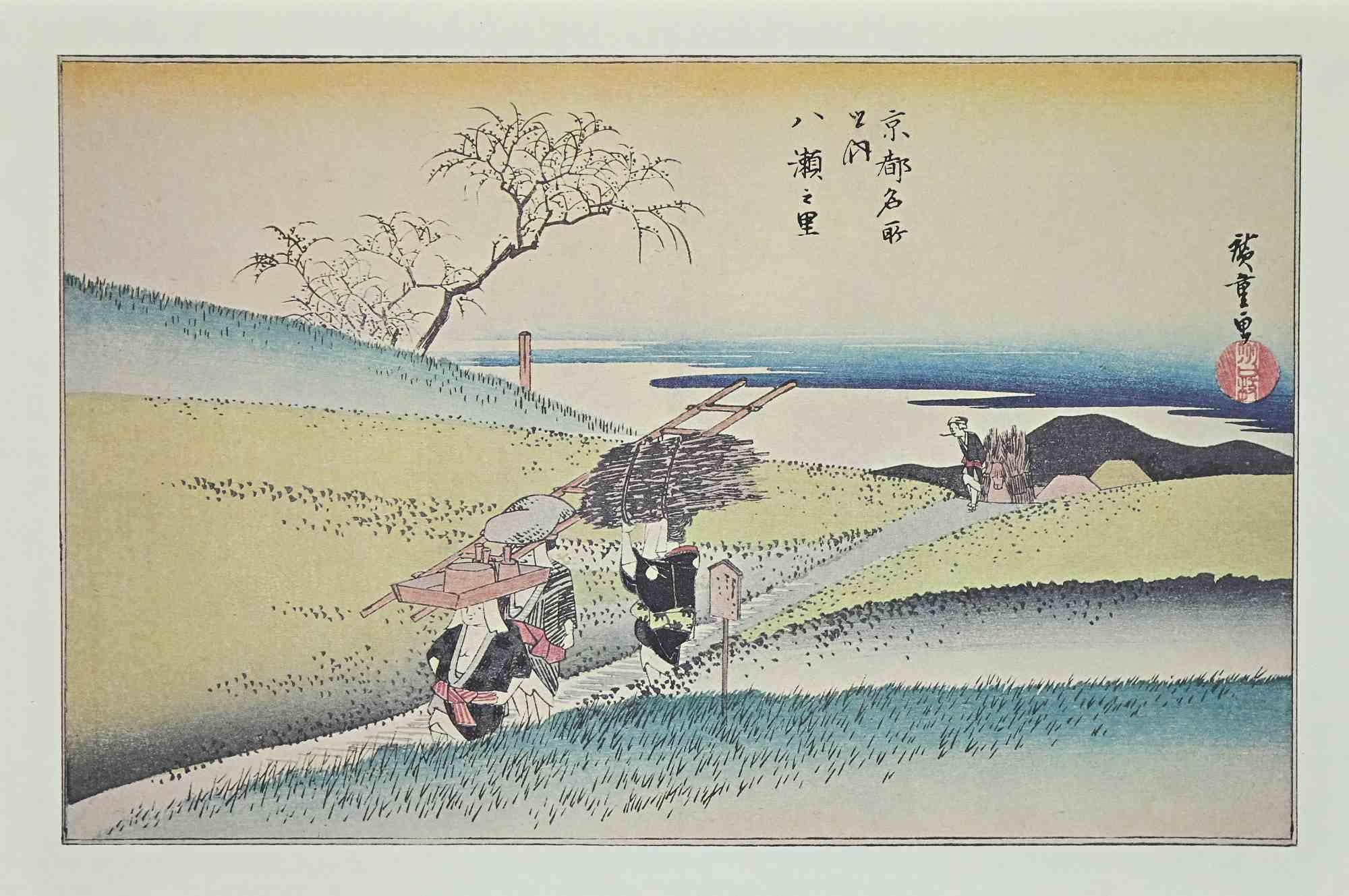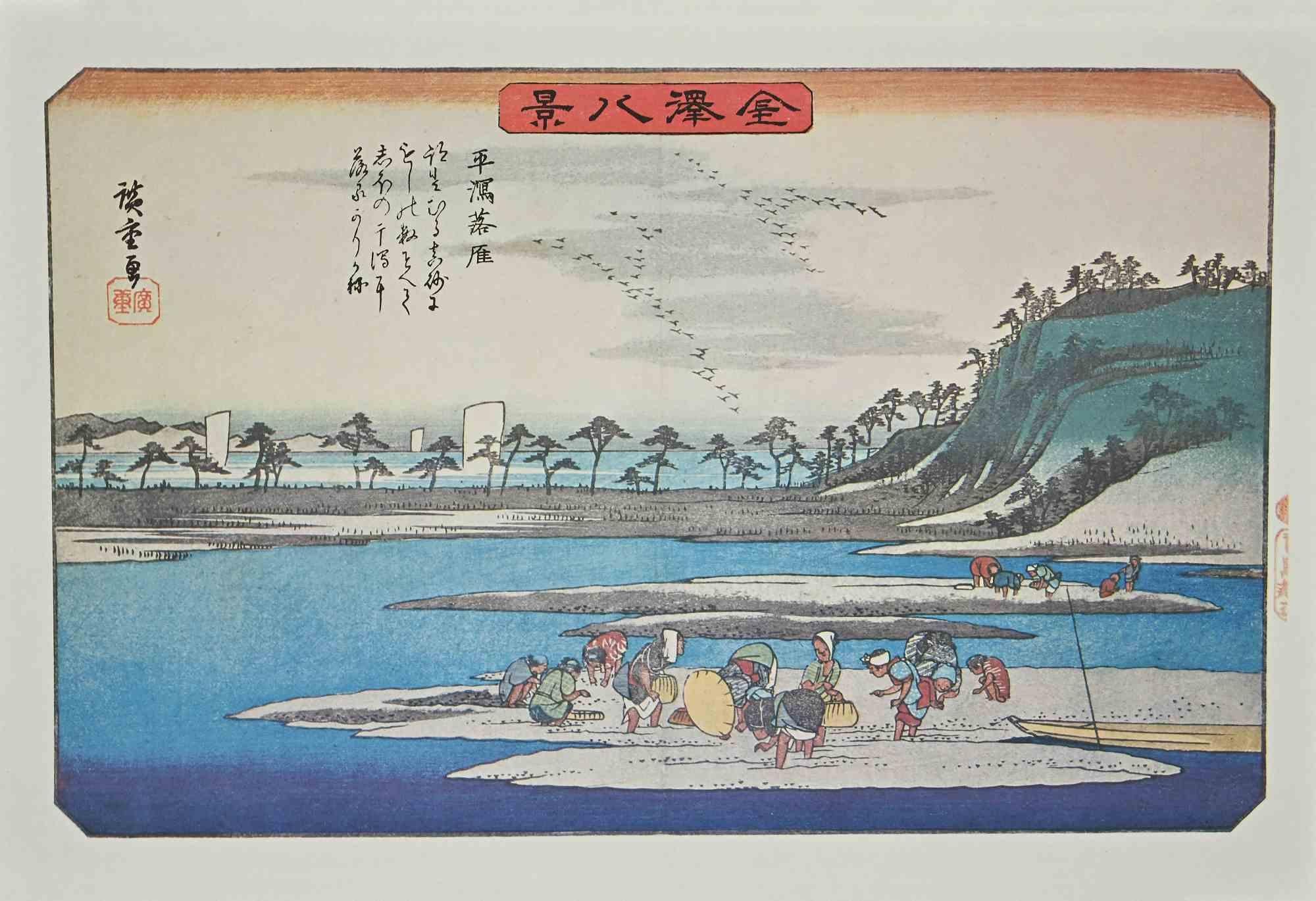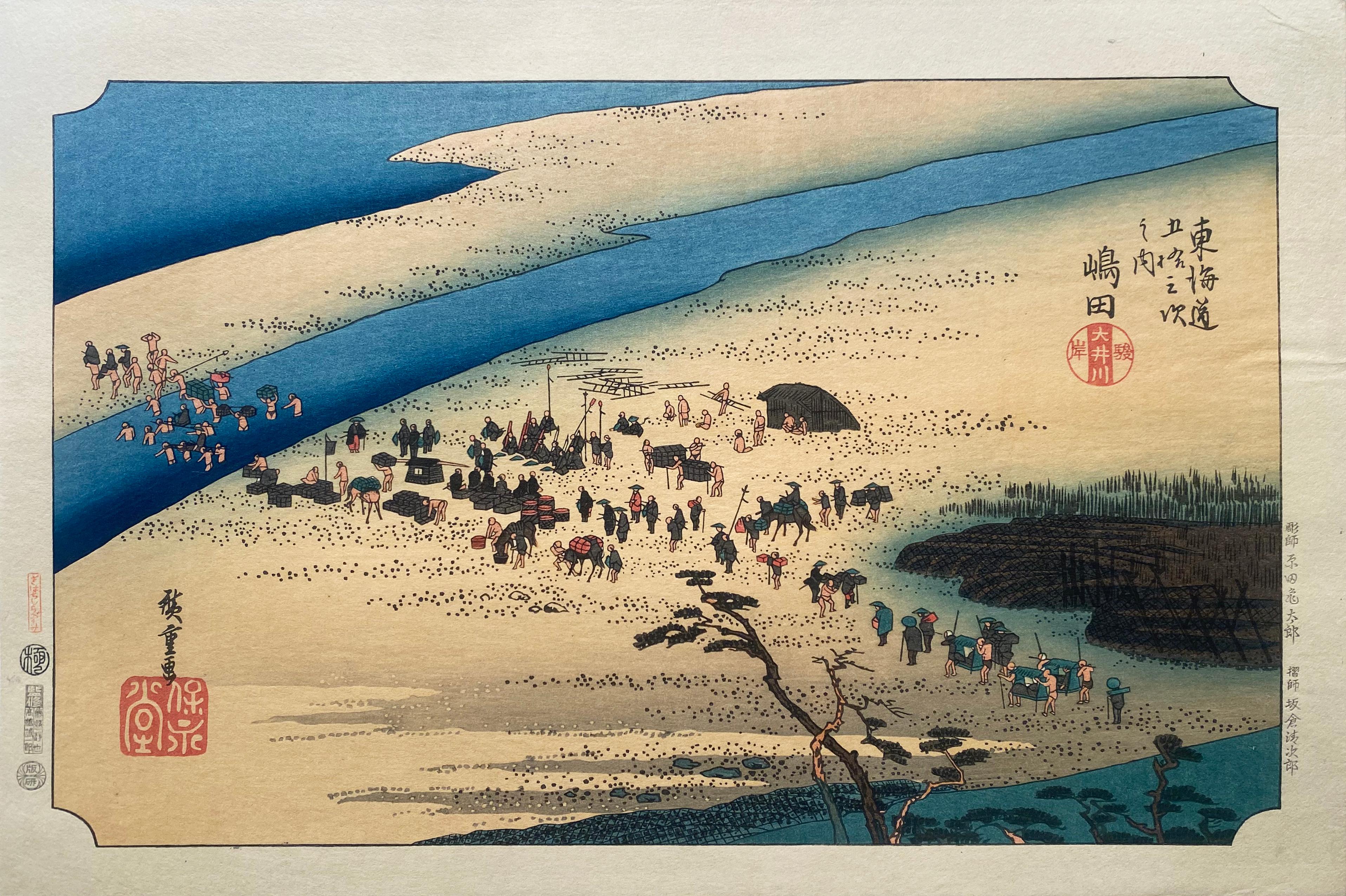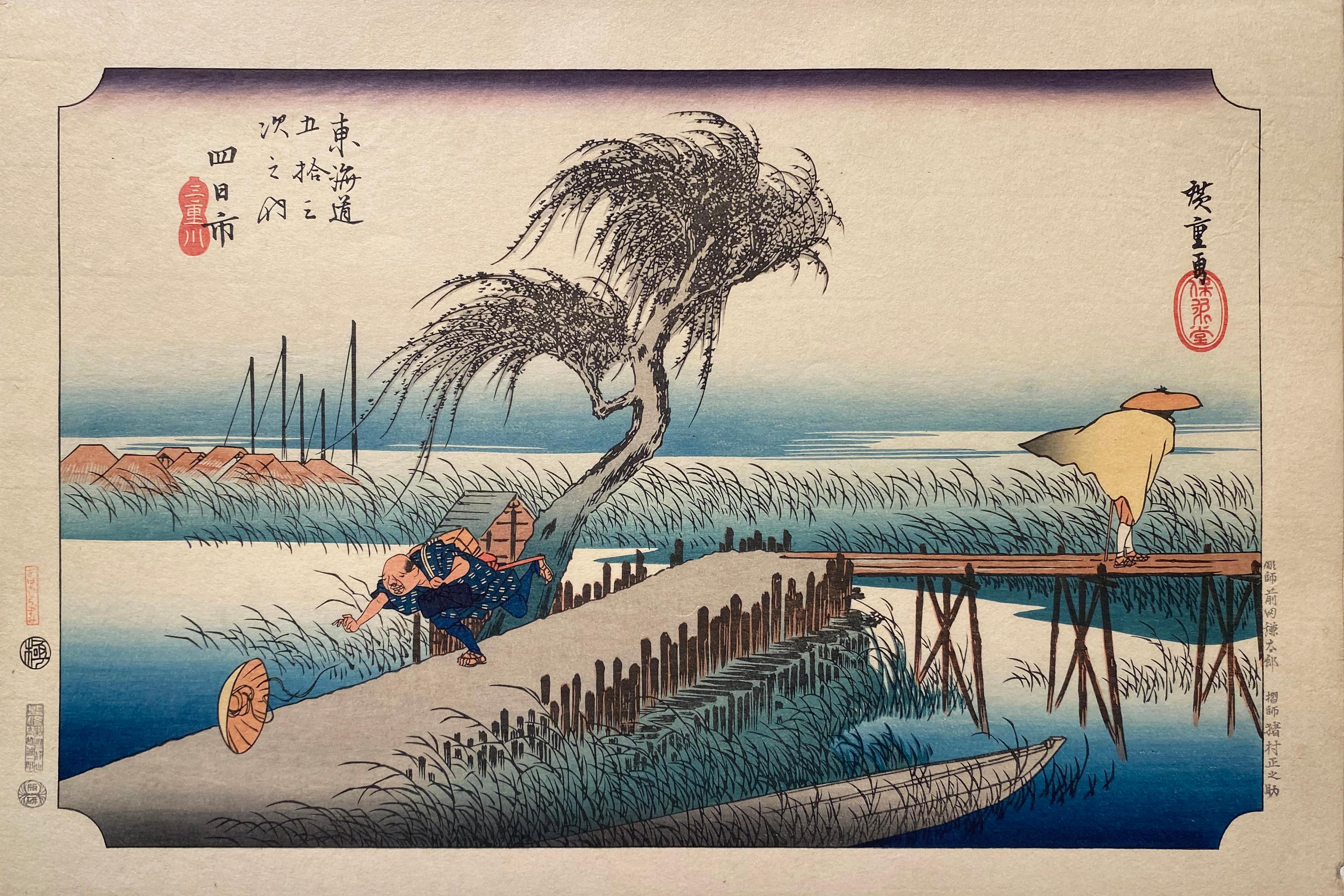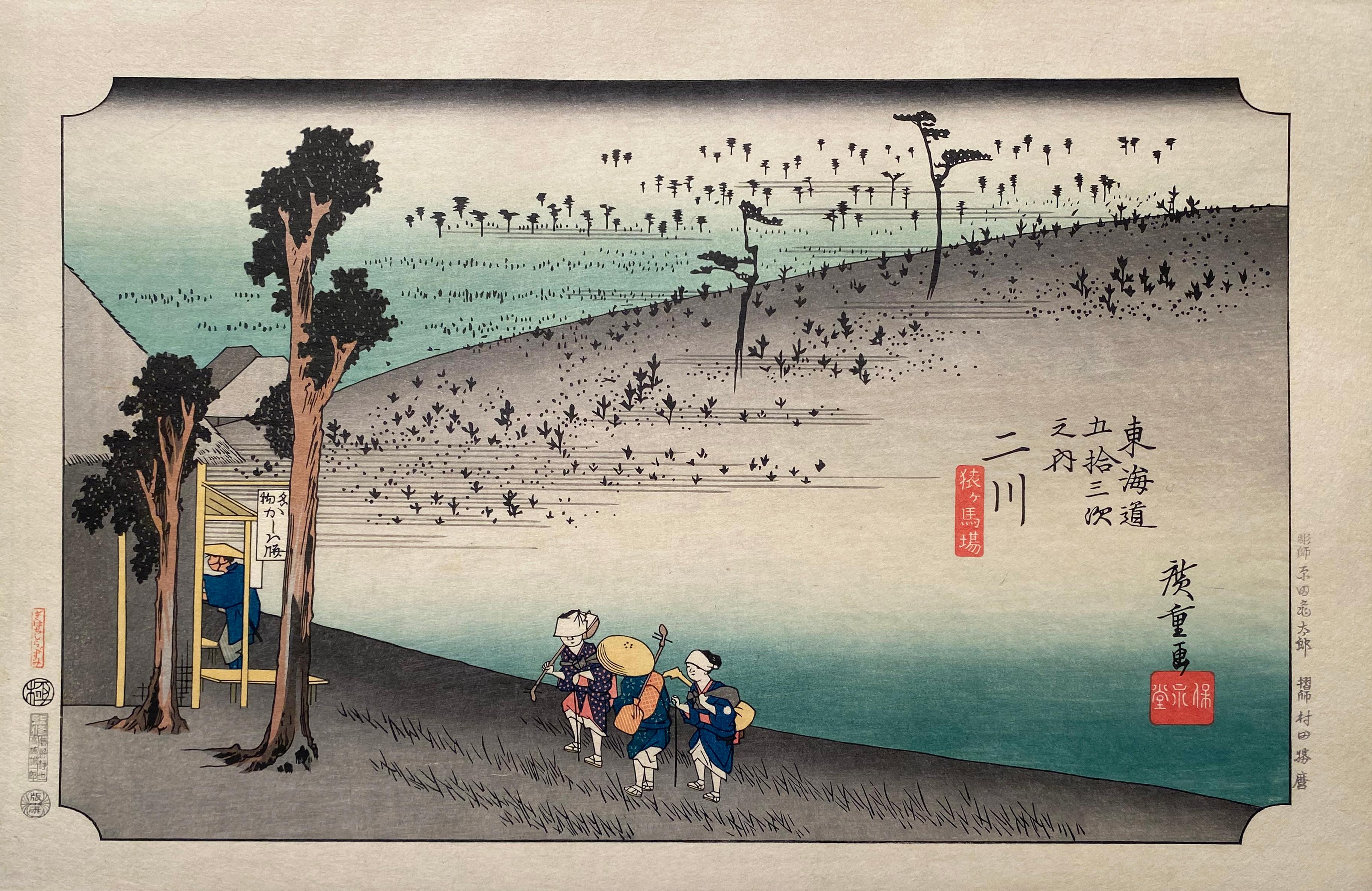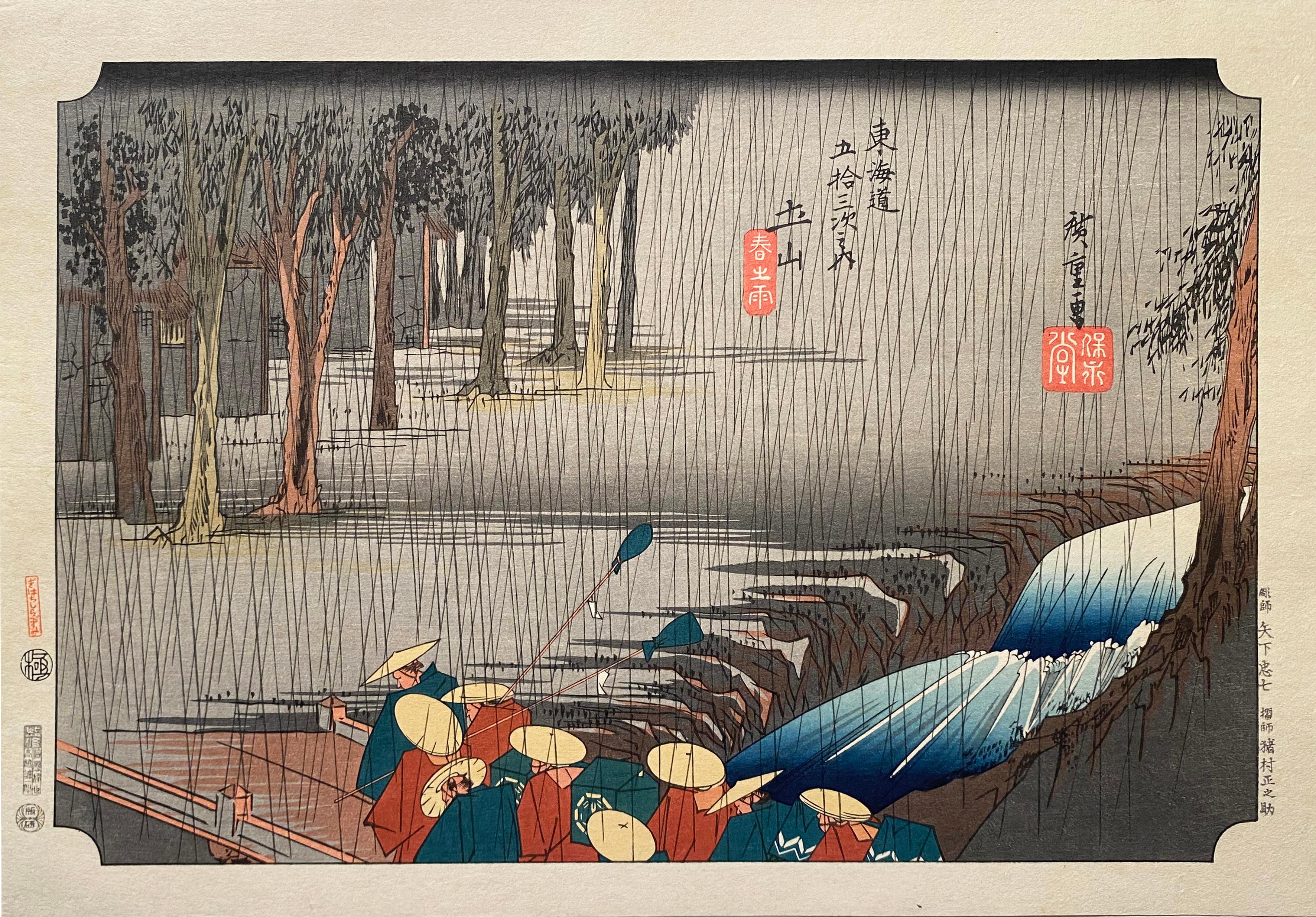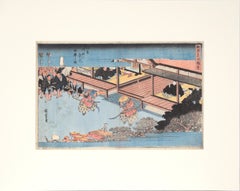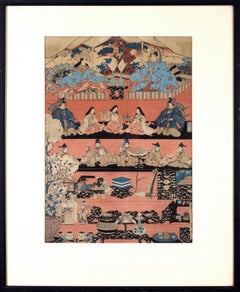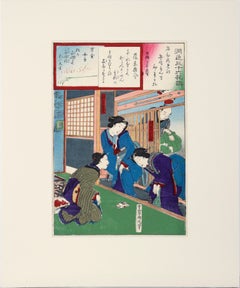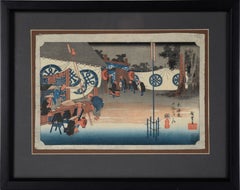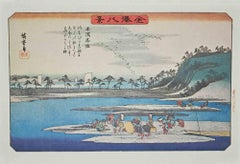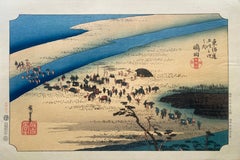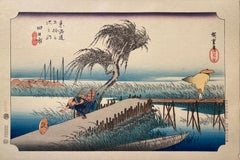Items Similar to "Plovers at Tamagawa" from "Six Jewel Rivers" - Woodblock Print on Paper
Want more images or videos?
Request additional images or videos from the seller
1 of 16
Kubo Shunman"Plovers at Tamagawa" from "Six Jewel Rivers" - Woodblock Print on Paperc. 1787
c. 1787
$880
$1,10020% Off
£669.10
£836.3720% Off
€770.81
€963.5120% Off
CA$1,251.13
CA$1,563.9120% Off
A$1,359.76
A$1,699.7020% Off
CHF 718.58
CHF 898.2320% Off
MX$16,450.18
MX$20,562.7320% Off
NOK 8,949.41
NOK 11,186.7720% Off
SEK 8,453.28
SEK 10,566.6020% Off
DKK 5,754.98
DKK 7,193.7220% Off
About the Item
"Plovers at Tamagawa" from "Six Jewel Rivers" - Woodblock Print on Paper
This print, sometimes titled "Chidori No Tamagawa" "Plovers at Tamagawa", is from the series Mu Tamagawa ("Six Views of Tama River", also known as "Six Jewel Rivers" or "Six Crystal Rivers") by Kubo Shunman (Japanese 1757-1820). Three women stand by the Tama River while plovers dive overhead. Two of the women, perhaps a courtesan and a village girl, smoke their pipes. A strong breeze is blowing and the leaves of the Japanese maple tree to the right suggest it is autumn. The scenery is echoed in the river design in the kimono of the woman at the left, with a delicate embossed pattern.
The series by Shunman represented rivers in six provinces - Ide (Hagi) no Tamagawa in Yamashiro, Mishima (Tôi or Kinuta) no Tamagawa in Settsu, Noji no Tamagawa in Omi, Kôya no Tamagawa in Kii, Chôfu no Tamagawa in Musashi, and Noda (Chidori) no Tamagawa in Mutsu (depicted in this print). Each of the rivers was associated with a classical poem. This print was the second from the left in Shunman's series of six prints, which could be placed next to each other to make a hexaptych.
Artist's signature and red ink chop in the lower right corner.
Presented in a wood frame with a cream mat.
Frame size: 21"H x 16"W
Paper size: 15"H x 10"W
- Creator:Kubo Shunman (1757 - 1820, Japanese)
- Creation Year:c. 1787
- Dimensions:Height: 21 in (53.34 cm)Width: 16 in (40.64 cm)Depth: 0.75 in (1.91 cm)
- Medium:
- Movement & Style:
- Period:
- Condition:Tonal ageing to paper, as expected. Frame shows signs of wear.
- Gallery Location:Soquel, CA
- Reference Number:Seller: DBH76091stDibs: LU54211555202
About the Seller
5.0
Platinum Seller
Premium sellers with a 4.7+ rating and 24-hour response times
Established in 1986
1stDibs seller since 2014
3,012 sales on 1stDibs
Typical response time: <1 hour
- ShippingRetrieving quote...Shipping from: Soquel, CA
- Return Policy
Authenticity Guarantee
In the unlikely event there’s an issue with an item’s authenticity, contact us within 1 year for a full refund. DetailsMoney-Back Guarantee
If your item is not as described, is damaged in transit, or does not arrive, contact us within 7 days for a full refund. Details24-Hour Cancellation
You have a 24-hour grace period in which to reconsider your purchase, with no questions asked.Vetted Professional Sellers
Our world-class sellers must adhere to strict standards for service and quality, maintaining the integrity of our listings.Price-Match Guarantee
If you find that a seller listed the same item for a lower price elsewhere, we’ll match it.Trusted Global Delivery
Our best-in-class carrier network provides specialized shipping options worldwide, including custom delivery.More From This Seller
View AllSumiyoshi: Dengaku dance performed during an Onda ceremony - Woodblock Print
By Utagawa Hiroshige
Located in Soquel, CA
Sumiyoshi: Dengaku dance performed during an Onda ceremony - Woodblock Print
Bright woodblock print by Utagawa Hiroshige (Japanese, 1797-1858). In this scene, two dancers with swords and fans are facing each other, in the center of a courtyard. There are spectators surrounding them, including nobles in black clothing on a balcony.
Presented in a new off-white mat with foamcore backing.
Mat size: 16"H x 20"W
Paper size: 9.63"H x 14.5W"
Utagawa Hiroshige (1797-1858, sometimes called Ando Hiroshige) was the second of the two great masters of the Japanese landscape woodblock print...
Category
1830s Edo Figurative Prints
Materials
Ink, Rice Paper, Woodcut
"Various Himochi" Wagashi Festival Japanese Woodblock Print by Utagawa Toyokuni
By Utagawa Toyokuni
Located in Soquel, CA
"Various Himochi" Wagashi Festival Japanese Woodblock Print by Utagawa Toyokuni
Rare oversized early 19th century 5-tiered woodblock by Utagawa Ichiyosai Toyokuni, (Japan, 1769-1825), a Japanese lord and wife oversee a sekku festival of food, music, and dolls or toys. '"oshi" is the first day of “Mi (Snake)” in the third month of the lunar calendar. This day, known in modern Japan as the Girls' Festival, originated in China as a form of purification ceremony in which water and drinking peach blossom wine were used to drive away evil. Many kinds of hishi-mochi appear in this picture of hina ningyo (dolls associated with Hinamatsuri, or the Girl’s Day) from Omochae.
The custom of eating special dishes at events throughout the year and at milestones in people's lives has existed since ancient times. This paragraph specifically focuses on the annual event called sekku, and life events that involve eating sweets. Joshi is the first day of “Mi (Snake)” in the third month of the lunar calendar. This day, known in modern Japan as the Girls' Festival, originated in China as a form of purification ceremony in which water and drinking peach blossom wine were used to drive away evil. According to the Keiso saijiki, in ancient China, on the third day of the third lunar month, people ate “ryuzetsuhan,” which is the juice of gogyo (Jersey cudweed) mixed with rice flour and nectar. In Japan, there is a record in the Heian period history book Nihon Montoku tenno jitsuroku [839-5] that it was an annual event to make kusamochi using gogyo on the third day of the third month of the lunar calendar, which may have been influenced by Chinese customs.
The tradition of eating kusamochi on the third day of the third month of the lunar calendar continued after that. By the Edo period, however, hishimochi had come to be used as a sweet to serve on the third day of the third month. A picture of a hishimochi is included in the Morisada manko , which we mentioned in Part 1. According to it, hishimochi in the Edo period were often three layers of green-white-green instead of the now common red-white-green. However, it is possible to see from our collection that not all hishimochi were made in this way. Omochae published in 1857, is a good example. Omochae is a type of ukiyoe print...
Category
1820s Edo Figurative Prints
Materials
Ink, Rice Paper, Woodcut
"Enshoku Sanju-roku Kasen" (Thirty-six Enchanting Flowers) Woodblock on paper
By Toyohara Kunichika
Located in Soquel, CA
"Enshoku Sanju-roku Kasen" (Thirty-six Enchanting Flowers) Woodblock on paper
Elegant woodblock print by Toyohara Kunuchika (Japanese, 1835-1900). Three women are in talking with each other inside, while a man waits outside holding a bag of some kind. The colors in this piece are rich and saturated, primarily blues, greens, and purple.
Mat size: 16"H x 20"W
Paper size: 14.75"H x 9.88"W
Born in 1835, Toyohara Kunichika grew up in the Kyobashi district of Edo in the midst of merchants and artisans. In 1848, at age 13, he was accepted as an apprentice into the studio of Utagawa Kunisada I...
Category
1880s Edo Figurative Prints
Materials
Ink, Rice Paper, Woodcut
Stage 48 of the 53 Stages of the Tokaido - Japanese Woodblock on Rice Paper
By Utagawa Hiroshige
Located in Soquel, CA
Stage 48 of the 53 Stages of the Tokaido - Japanese Woodblock on Rice Paper
Woodblock print of clothing vendors by Utagawa Hiroshige (Japanese, 1797-1858). Originally printed in 183...
Category
1830s Impressionist Figurative Prints
Materials
Rice Paper, Woodcut
Mitate of a Daimyo's Procession Crossing Ryogoku Bridge - Woodblock Print
By Keisai Eisen
Located in Soquel, CA
Mitate of a Daimyo's Procession Crossing Ryogoku Bridge - Woodblock Print
Woodblock print of a procession by Keisai Eisen (Japanese, 1790–1848). Terrific triptych of a procession of...
Category
Early 19th Century Edo Figurative Prints
Materials
Ink, Rice Paper, Woodcut
Kiyomizu Temple, Scenes of Famous Places along Tôkaidô Road - Woodblock on Paper
By Utagawa Hiroshige II
Located in Soquel, CA
Kiyomizu Temple, Scenes of Famous Places along Tôkaidô Road - Woodblock on Paper
Full Title:
Kyoto: Kiyomizu Temple (Kyô Kiyomizudera), from the series Scenes of Famous Places along...
Category
1860s Edo Landscape Prints
Materials
Ink, Rice Paper, Woodcut
You May Also Like
Scenic Spots in Kyoto-Lithograph After Utagawa Hiroshige-Mid 20th Century
By Utagawa Hiroshige
Located in Roma, IT
Scenic Spots in Kyoto is a modern artwork realized in the Mid-20th Century.
Mixed colored lithograph after a woodcut realized by the great Japanese artist Utagawa Hiroshige in the 1...
Category
Mid-20th Century Modern Figurative Prints
Materials
Lithograph
Eight Scenic Spots in Kanazawa - Lithograph after Hiroshige - Mid 20th century
By Utagawa Hiroshige
Located in Roma, IT
Eight Scenic Spots in Kanazawa is a modern artwork realized in the Mid-20th Century.
Mixed colored lithograph after a woodcut realized by the great Japanese artist Utagawa Hiroshige in the 19th century.
Very Good conditions.
Collect an oriental artwork...
Category
Mid-20th Century Modern Figurative Prints
Materials
Lithograph
'View of Shimada', After Utagawa Hiroshige 歌川廣重, Ukiyo-e Woodblock, Tokaido
By Utagawa Hiroshige (Ando Hiroshige)
Located in Santa Cruz, CA
An ink on paper, Nishiki-e and Yoko-e woodblock landscape showing a view of travelers crossing the Suruga bank of the Ōi River, circa 1850. Signed in Kanji lower left, "Hiroshige Ga"...
Category
Mid-20th Century Landscape Prints
Materials
Sumi Ink, Washi Paper
'Winds at Yokkaichi', After Utagawa Hiroshige 歌川廣重, Ukiyo-e Woodblock, Tokaido
By Utagawa Hiroshige (Ando Hiroshige)
Located in Santa Cruz, CA
An ink on paper, Nishiki-e and Yoko-e woodblock landscape showing a view of two figures fighting wind gusts along the Mei River. Signed in Kanji upper right, "Hiroshige Ga" for Utaga...
Category
Mid-20th Century Landscape Prints
Materials
Sumi Ink, Washi Paper
'View of Futakawa', After Utagawa Hiroshige 歌川廣重, Ukiyo-e Woodblock, Tokaido
By Utagawa Hiroshige (Ando Hiroshige)
Located in Santa Cruz, CA
An ink on paper, Nishiki-e and Yoko-e woodblock landscape showing a view of the Sarugababa (Monkey Plateau) rest stop at Futakawa, circa 1850. Signed in Kanji lower right, "Hiroshige...
Category
Mid-20th Century Landscape Prints
Materials
Sumi Ink, Washi Paper
'A View of Tsuchiyama', After Utagawa Hiroshige 歌川廣重, Ukiyo-e Woodblock, Tokaido
By Utagawa Hiroshige (Ando Hiroshige)
Located in Santa Cruz, CA
An ink on paper, Nishiki-e and Yoko-e woodblock landscape showing a daiymo procession caught in the rain. Signed in Kanji lower left, "Hiroshige Ga" for Utagawa (Ando) Hiroshige (Jap...
Category
Mid-20th Century Landscape Prints
Materials
Sumi Ink, Washi Paper
